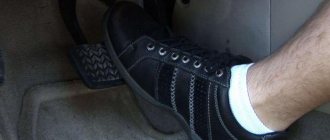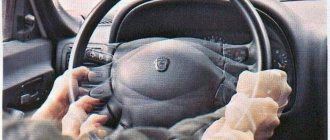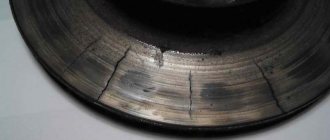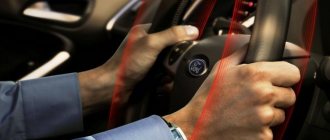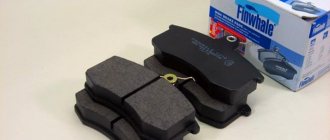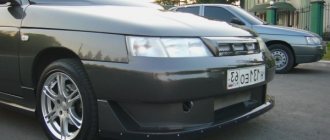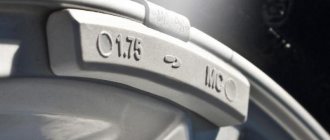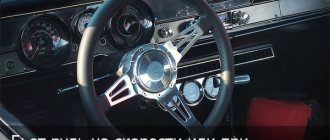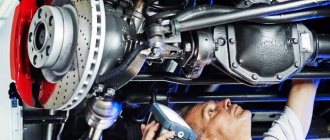It's no secret that you need to take care of your car. When internal systems do not work properly, an unpleasant phenomenon can occur in which the steering wheel begins to vibrate during the operation of the braking system. Such circumstances greatly interfere with movement. The sensation of beating occurs, as a rule, due to impacts or deformation of the discs. One way or another, the damage needs to be fixed.
Find out the cost of diagnosing the brake system online in 3 minutes Don't waste your time - use the Uremont search and get offers from nearby services with specific prices!
Get prices
Where does steering wheel wobble come from?
Steering wheel beating at the moment of braking means spontaneous jerking of the steering wheel in different directions.
In especially advanced cases, the vibration is so strong that the driver has to literally catch the car on the road. At speeds above 50 km/h, the phenomenon creates a real danger for vehicle passengers. Since the steering wheel is rigidly connected to the front wheel hubs through a rack and ball ends, the source of the problem must be sought in the chassis and braking system of the car. The main causes of strong vibration lie in various defects of the brake disc:
- the working part of the product is deformed and has a wavy surface;
- due to the impact, the disk was damaged and cracked;
- The spare part was originally defective or installed incorrectly.
It is no coincidence that the front brake discs are named as the culprits. As soon as the working surface of the part changes its shape a little or gets a defect, after the pads are activated, the front wheels will begin to wobble, repeating the rotation of the uneven element. The steering wheel hits even harder when braking at high speed, as the speed of the front wheels increases.
How a wave-like deformation appears on a disk:
- As the car moves, the elements are repeatedly captured by the pads and can become very hot.
- The temperature is distributed unevenly over the surface; accordingly, the metal in different parts of the part expands more or less.
- If, at the moment of maximum heating, the wheel falls into a puddle or snow, the metal cools sharply and retains its concave shape.
- The brake pads grip the disc and force the wheel to follow the path of rotation of the deformed surface. This is why the steering wheel shakes when braking.
Steering wheel runout also appears after the element is incorrectly fastened or in the presence of a manufacturing defect, when the surface of the spare part is initially curved.
Steering wheel vibration continues even after replacing discs, hubs or bearings
If you have already repaired the chassis and the vibration continues, then you need to look for the reasons in this system. If you have replaced the hub, brake discs or bearing, then the problem may not only be due to a low-quality part. The technician or you yourself may have tightened the fastening elements incorrectly.
Poorly performed work is one of the main reasons why strong vibration occurs. It is for this reason that you need to look for a proven contractor who has a good reputation among clients. If vibration appears after replacing one of the three above-mentioned parts, then you can go to the specialist with a complaint.
The vibration could also be caused by a crack in the brake disc. The disc cracks due to impact or any other type of mechanical impact. This type of damage can occur on worn brakes. Worn pads cannot cause vibration. This part does not move - it all depends on the surface of the brake disc.
The main reasons why steering wheel wobble occurs when the vehicle speed decreases:
- Problems with the steering rack or wear of the ball joints of the chassis system.
- Incorrect functioning of the shock absorbers - the steering wheel shakes when the car maneuvers.
- The shock absorber support elements are worn out or will soon simply break.
- A sharp and strong impact on the disk - vibration occurred after hitting a curb or in the event of a collision.
- Steering wheel vibration may begin due to problems with the steering tip.
How to determine the cause
Before drawing any conclusions regarding why the steering wheel shakes when braking, you need to carefully examine all the components of the units. Perhaps the reason is more than clear. And you can make an approximate repair estimate yourself.
If the steering wheel shakes when braking, first of all we check the brake drums, discs and pads.
The disk must have a perfectly round, smooth surface. If they are deformed, “went in waves”, “bumps” have formed or are extremely worn out, it is worth considering why. The car owner could save on quality components and bought a fake from an unknown manufacturer. A very hot disk could get into a puddle or snow. Strong temperature changes are detrimental to metals. Or the driver applied emergency braking, and at that moment the pads left grooves or bent the disc. Previously overheated metal can be easily identified by its bluish tint.
The brake drum must also be perfectly round. It is worth considering that it is still more difficult to deform than a disk.
The pads must be intact and unworn. Check the condition of these mechanisms regularly.
Possible solutions
Once you have decided on the possible options for why the steering wheel shakes when braking, you need to think about the best solution to the problem.
If the cause is discs, drums or pads, these mechanisms should be replaced immediately. Operating the vehicle is not recommended until the repair is completed.
If the diagnostics revealed backlashes and gaps in the steering rod, they must be eliminated in a timely manner.
A worn ball joint requires immediate replacement. Otherwise, this may lead to her vomiting the first time she falls into a large hole, of which we have plenty on our roads. Operating the car before replacement is also highly undesirable.
If the balance is disturbed, it is worth visiting a tire workshop. Don't forget that all four wheels need to be balanced at once.
If possible, dirt should be washed off with a strong jet or cleaned mechanically. You should not be too zealous so as not to accidentally damage other units.
Loose bolts and nuts must be checked promptly and tightened as necessary. After fitting the tires, always check the tightness of the tires yourself. Remember that the nuts should also not be tightened too tightly to avoid deformation of the wheel rim.
Try to choose repair centers equipped with a torque wrench.
Brake system elements
Most often it hits the steering wheel when braking due to problems with the system of the same name. And this can happen due to:
- DEFORMATION OF BRAKE DISCS. This is one of the most common reasons. As a result of friction with the pads, the brake disc heats up quite strongly during braking, and if it is cooled sharply (for example, water from a puddle immediately gets on it), it warps (its geometric shape is disrupted). The curvature of the working surfaces of the disc leads to runout in the pads, which is transmitted to the caliper, and from it, in turn, to the hub and steering rods. But warping of the rear brake discs or drums will turn into strong vibration of the body. The problem can be fixed either by grooving the brake discs (a method that allows work to be done without removing the element from the car) or by replacement;
- UNEVEN WEAR OF THE PADS AND THEIR DAMAGE. In this case, the runout will be caused by the uneven surface of the friction linings. Since the pads are worn in to the working surfaces of the brake discs, when replacing or turning the latter, they must be changed;
- WEDDING THE CALIPER. Often the caliper guides become stuck in their mounting holes. Because of this, the caliper will press the pads unevenly when braking and the driver will feel a beating in the steering wheel. Everything can be “cured” by disassembling the unit, cleaning and lubricating its guides and their seats.
Note that problems with the braking system often manifest themselves not only in the steering wheel, but also in the brake pedal.
Also, in the case of a jammed caliper, the car may brake unevenly (jerky).
Knowing additional symptoms can significantly narrow down the search for the causes of the malfunction.
Loose bolts and nuts
“The steering wheel shakes when braking. VAZ 2110,” is a phrase that a mechanic at a service station can often hear. First of all, of course, he will check how tightly the bolts are tightened. The source of the problem is obvious and extremely simple. But at the same time one of the most dangerous. If you “forgot” to tighten the nuts while working at a tire shop, the wheel may “fall off” during one of the maneuvers, which can lead to serious injuries. Over-tightened bolts can deform the wheel rim, which can also cause it to vibrate.
Loose nuts, in addition to the wheel flying off, can cause serious repairs to wheel and brake discs, pads, and hubs. Bolts, cotter pins, and mounting holes in disks are also damaged.
Personally control the tightening of the bolts, which will help avoid many problems in the future.
How to detect wear on brake discs?
Before repairing, it is necessary to diagnose the breakdown.
Is it just the steering wheel that vibrates? The likely cause is wear of the front brake discs or the system as a whole. Has the brake pedal also changed its behavior? Pay attention to the rear braking system. The handbrake can be used to determine the malfunction. If the vibration stops when using it, then you should look for a problem in the front brake system. Is there any beat left? Examine the technical condition of the rear brake discs and the system as a whole. The procedure allows you to determine the location of deformed parts.
Next, you should test the wheels or study the appearance of the brake discs. Raise the car on a jack and remove it from gear. If the rear axle is suspected, then the handbrake must be lowered. Spin the wheel. Is the rotation uneven and changing intensity in the same place? The problem has been identified. If the test result is negative, move on to the next wheel.
The appearance of the brake disc says a lot about its technical condition. Noticed cracks, unevenness or chips? Replacement or grooving is required, depending on the situation. The presence of a bluish tint on the surface is a sign of overheating.
When inspecting, pay attention to the brake calipers. It's unlikely, but they can also cause vibrations in the steering wheel.
Know-how
Carrying out all of the above yourself means losing a colossal amount of effort and time. Without experience in this area, you should seek help from professionals who will help you save money and quickly troubleshoot problems, after which the vibration will stop. In addition, you will have to take responsibility for possible problems due to improper self-repair.
We offer the website Uremont.com. Here users find the highest quality car repair companies. The resource constantly updates information for a more accurate understanding of the reputation of services. The aggregator will allow you to order a service directly on the website and not waste time in line.
Checking the steering mechanism
The car will need to be raised using a jack. The first thing you will need to pay attention to is the tie rod ends. There should be no gaps. Check the play of the rod - you need to grab it and pull it. Your assistant should hold the steering wheel firmly at this time.
Carefully inspect the steering rack - wear may be one of the reasons why the steering wheel shakes when braking at high speed.
Diagnostics
“Why does the steering wheel shake when braking?” — this question should first be asked to a car service mechanic. According to the traffic rules, it is prohibited to drive onto public roads with a faulty steering brake system. Of course, you can examine your car yourself or entrust this to a “specialist” in a garage cooperative. But after that, it’s still worth sending it to a professional for diagnostics. The most reliable option is a warranty workshop. This is especially important if the car was purchased recently. If the car is used, then at the local auto forum the regulars will suggest a mechanic you can trust. But be careful, you can end up with expensive repairs if you encounter a scammer.
Remember, the sooner you diagnose the problem and go for repairs, the cheaper it will cost you.
Before diagnostics, you should drive on a deserted highway at different speed ranges - slow, medium, fast. Determine whether the steering wheel shakes when braking or accelerating. At what speeds does the beat appear, at which it becomes greater, at which it disappears. Does the vibration depend on smooth acceleration and braking or only on sharp ones?
Elimination of vibrations
Eliminating the problem after it has been identified, and not vice versa, is the main task. Then, depending on your means and capabilities, either repair it yourself or turn to professionals. Now, having heard a knock in the steering wheel on bumps and at speeds, or when braking, the steering wheel hits, you already understand the reason for the phenomenon. What to do with damaged parts:
A bent cardan or drive elements on the front wheels can only be replaced. Silent blocks must only be replaced.
Don’t forget to check the upper balls along with the lower ones. Of course, the lower ones bear more load, but the upper ones also fail gradually.
I recommend not agreeing to repair or replace broken suspension parts - reconditioned (refurbished), especially when the factory does not provide for such repairs. Aren't you tired of living? I definitely don't.
They usually try to adjust the steering mechanism, since it has special bolts for adjustment. Yes, and the fasteners sometimes become loose due to vibration, and if adjustment is impossible, they are replaced.
Discs and drums are ground if the thickness of the metal allows, otherwise they are also replaced.
No one will straighten the pads, only change them, and replacing all the pads at once, or on two parallel wheels, replacing one at a time does not solve the problem. The new pad is not worn out, the others have already worn out to some extent, and when braking we get what we were struggling with. A visual video on the topic : Wheel alignment should be checked at every TO-1, and tire balancing is recommended after 5 thousand mileage, even if your steering wheel does not knock. Timely completion of maintenance, which is prescribed by manufacturers and is required in the car manual, helps to find a fault in a timely manner, without waiting for the steering wheel to begin to vibrate and the car to lose control.
Try our service station selection service
Creating an application is absolutely free and will take you no more than 5 minutes
Many car enthusiasts, when operating their cars when braking, especially at high speeds over 80 km/h, begin to hit the steering wheel. But it happens that the driver feels vibration in his hands even when driving at low speeds.
This problem is quite dangerous, because during braking the driver loses control of the car due to beating in the steering wheel; in some cases, the vibration is so strong that it practically knocks the steering wheel out of his hands.
Should you pay attention to the runout if it does not interfere with your ride?
In the event of steering vibration or its transmission throughout the entire body of the car, it would be safer not to bring the situation to a critical level, but to contact a specialist. As a rule, the problem does not require a solution as quickly as possible - you can drive with it for months (and sometimes years). On the other hand, it should be remembered that if the nuts are not tightened properly, the behavior of the brake disc may be unpredictable, which affects driving safety. At the same time, the beating also loads the parts of the chassis system: shock absorbers, steering, parts of the hub - and in the event of a breakdown, all these elements (as well as their replacement) will not be cheap.
In addition to the above, we note that beating at high speed is very dangerous - strong vibration can lead to loss of control of the car, and, as a result, to an accident. Driving in itself is already a source of increased danger for the driver and others. In this regard, it is better not to skimp on eliminating the causes of vibration.
By the way, many motorists don’t even realize how ridiculous they look from the outside with a vibrating steering wheel; remember this when you drive your family or just give a ride to a fellow traveler - from the outside, a shaking steering wheel looks very noticeable.
Danger of resulting vibrations
It's fair to say that slight vibrations during braking often don't lead to any immediate problems. Usually they can continue to manifest themselves with the same intensity for several months, even years.
In case of light vibrations, in order to extend the life of the car and not have to deal with repairs, be sure to exclude any maneuvers that require emergency braking.
If you do not brake sharply, pressing the brake pedal to the floor, there is a good chance of avoiding expensive repairs in the next 1-2 years. It all depends on the specific circumstances.
But at the same time, when vibrations continue for a long time, they have a negative impact on the braking system, chassis and suspension. As a result, the service life of these components is reduced, which subsequently results in expensive and complex repairs.
By not making repairs when slight vibrations occur that become noticeable in the steering wheel, in the short term you can save some money on diagnostics and repairs. But if we talk about long-term prospects, then there is no question of any savings. By postponing a visit to a car service center, you gradually increase the amount of money that you will have to invest in restoring a car worn out by vibrations.
As soon as you feel a strong and sharp blow to the steering wheel, pressing the brake again, some unit has almost failed, and during the next braking it may fail completely. It is strongly not recommended to delay until such a situation arises. This is already a matter of your safety and life, since a breakdown while the car is moving can result in a serious accident with all the ensuing consequences.
Prevention
In order not to understand the causes of steering wheel vibration, the best option would be timely diagnosis and prevention of the chassis and brakes. Sometimes you don’t even need to use the services of car services; some problems can be identified visually using certain signs. For example, if the brake disc has acquired a bluish color, this indicates that it is subject to constant overheating and in this case it is necessary to look for the cause. The same applies to the appearance of waves on the surface.
Try to visit a tire shop regularly so that the balancing of all wheels is constantly rechecked. If this is not done, the vibration can be quite strong, moreover, such an omission can lead to even bigger problems and then repair work will cost an order of magnitude higher. Also, if the tires wear out, it is necessary to replace them in order to prevent problems in other components, which can lead to the steering wheel wobbling.
conclusions
Any breakdown of a vehicle requires urgent and high-quality repairs. It is important to understand that all parts, especially in the chassis system, are subject to very significant and constant loads. If you refuse repair work, you may face huge financial costs in the future. In addition, this may affect the safety of the vehicle. Steering wheel vibration also has a detrimental effect on the ease of driving the car.
Sources
- https://autochainik.ru/bienie-rulya-pri-tormozhenii.html
- https://www.syl.ru/article/207313/new_bet-rul-pri-tormojenii-na-bolshoy-skorosti
- https://AutoTopik.ru/diagnostika-neispravnostei/1289-bet-rul-pri-tormozhenii.html
- https://AvtoNov.com/%D0%B2%D0%B8%D0%B1%D1%80%D0%B0%D1%86%D0%B8%D1%8F-%D1%80%D1%83% D0%BB%D1%8F-%D0%BF%D1%80%D0%B8-%D1%82%D0%BE%D1%80%D0%BC%D0%BE%D0%B6%D0%B5% D0%BD%D0%B8%D0%B8/
- https://howcarworks.ru/%D0%B2%D0%BE%D0%BF%D1%80%D0%BE%D1%81/%D0%B2%D0%B8%D0%B1%D1%80% D0%B0%D1%86%D0%B8%D1%8F-%D0%B8%D0%BB%D0%B8-%D0%B1%D1%8C%D1%91%D1%82-%D1%80 %D1%83%D0%BB%D1%8C-%D0%BF%D1%80%D0%B8-%D1%82%D0%BE%D1%80%D0%BC%D0%BE%D0%B6 %D0%B5%D0%BD%D0%B8%D0%B8-%D0%B2-%D1%87%D1%91%D0%BC-%D0%BC%D0%BE%D0%B3%D1% 83%D1%82-%D0%B1%D1%8B%D1%82%D1%8C-%D0%BF%D1%80%D0%B8%D1%87%D0%B8%D0%BD%D1% 8B
- https://mojcar.ru/ustrojstva-avtomobilya/podveska-i-rulevoe/pri-tormozhenii-bet-v-rul.html
- https://olade.ru/tryaska-rulya-vo-vremya-tormozheniya-simptomy-i-ustranenie
- https://DriverTip.ru/repair/pri-tormozhenii-poyavlyaetsya-bienie-rulya.html
- https://uremont.com/publications/articles/bienie-rulya-pri-tormozhenii
- https://auto-gl.ru/4-osnovnye-prichiny-bieniya-i-vibracii-rulya-pri-tormozhenii-i-2-sposoba-ih-ustraneniya/
